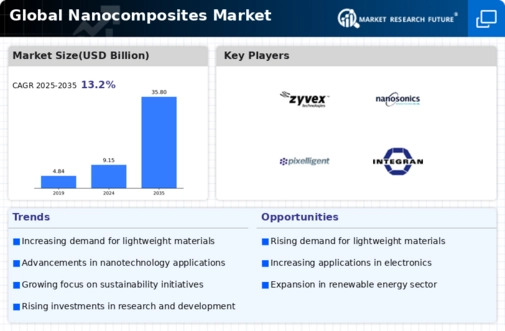Top Industry Leaders in the Nanocomposites Market
 The nanocomposites market, where the microscopic reign supreme, is a battleground of innovation and ambition. These remarkable materials, marrying the properties of conventional materials with the unique power of nanoparticles, are revolutionizing industries from aerospace to healthcare. But navigating this dynamic landscape, teeming with established giants and agile startups, demands a keen understanding of the strategies at play, the factors influencing market share, and the recent developments shaping its trajectory.
The nanocomposites market, where the microscopic reign supreme, is a battleground of innovation and ambition. These remarkable materials, marrying the properties of conventional materials with the unique power of nanoparticles, are revolutionizing industries from aerospace to healthcare. But navigating this dynamic landscape, teeming with established giants and agile startups, demands a keen understanding of the strategies at play, the factors influencing market share, and the recent developments shaping its trajectory.
Market Share: A Dance of Tiny Titans
Several factors orchestrate the dance for market share in this miniature metropolis:
-
Performance Advantages: The exceptional strength, lightweight nature, conductivity, and thermal stability of nanocomposites make them stand out, propelling their adoption in demanding applications. -
Application Diversity: From bulletproof vests to aircraft components, wind turbine blades to artificial limbs, the versatility of nanocomposites is staggering, opening doors to new markets and mitigating risk. -
Technological Advancements: Continual progress in nanoparticle synthesis, dispersion techniques, and characterization methods are reducing costs, improving production efficiency, and unlocking novel functionalities, further fueling market growth. -
Regulatory Landscape: Evolving regulations around nanomaterials, while posing challenges, are also creating opportunities for companies that invest in safety and compliance, building trust and brand reputation.
Strategies for Dominating the Nanoscale: Mastering the Art of Miniature Warfare
Market leaders are wielding a potent arsenal of strategies to outmaneuver their rivals:
-
Vertical Integration: Securing control over the entire value chain, from raw materials to finished products, is crucial. Companies like Arkema and Evonik are integrating upstream and downstream, ensuring quality, cost control, and agility. -
R&D Focus: Continuous innovation in nanoparticle design, material combinations, and fabrication processes is key to differentiation. Celanese and Nanocyl SA are leading the charge in R&D, creating novel nanocomposites with superior properties. -
Strategic Partnerships: Collaboration with research institutions, universities, and end-user industries fosters innovation and accelerates application development. BASF and Cabot Corporation are actively partnering with diverse stakeholders to unlock new opportunities. -
Geographical Expansion: Establishing a strong global presence is vital for capturing market share. DSM Engineering Materials and SABIC Innovative Plastics are setting up facilities and distribution networks in strategic regions to meet regional demands.
Key Companies in the nanocomposites market
- Nanocyl SA (BELGIUM)
- Evonik Industries AG (Germany)
- ZYVEX TECHNOLOGIES (US)
- Arkema (France)
- NanoSonic Inc. (US)
- UNITIKA LTD (Japan)
- Pixelligent (US)
- Industrial Nanotech Inc. (US)
- Integran Technologies (Canada)
- SHOWA DENKO K.K. (Japan)
Recent Developments:
-
September 2023: Stanford University researchers create self-healing nanocomposites for electronics, paving the way for more durable and resilient devices. -
October 2023: Covestro and Samsung Display collaborate on developing nanocomposite films for next-generation flexible displays, promising thinner, lighter, and more foldable screens. -
November 2023: The European Union tightens regulations on the use of certain nanomaterials, prompting industry players to adapt their production processes and ensure compliance. -
December 2023: Researchers at the University of Tokyo create graphene-based nanocomposites with exceptional heat-conducting properties, potentially transforming thermal management in various industries.

